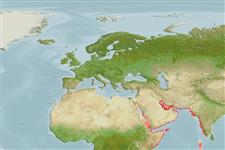Common names from other countries
Teleostei (teleosts) >
Gobiiformes (Gobies) >
Gobiidae (Gobies) > Gobiinae
Etymology: Amblyeleotris: Greek, amblys = darkness + The name of a Nile fish, eleotris (Ref. 45335).
More on author: Randall.
Environment: milieu / climate zone / depth range / distribution range
Ecology
Marine; demersal; depth range 13 - 20 m (Ref. 48637), usually 13 - 17 m (Ref. 90102). Tropical
Western Indian Ocean: known only from the Persian Gulf from Kuwait to Musandam. Reported from Mentawai Islands, eastern Indian Ocean.
Size / Weight / Age
Maturity: Lm ? range ? - ? cm
Max length : 14.0 cm SL male/unsexed; (Ref. 48637)
Dorsal spines (total): 7; Dorsal soft rays (total): 16; Anal spines: 1; Anal soft rays: 17. Characterized by whitish body color; side of body with four brown bars including caudal fin base; pale spaces between main body bars with narrower dark bars dorsally; presence of blackish spot above and behind upper opercular margin; operculum with irregular dusky brown blotch; pelvic fins united with frenum; without median predorsal scales; longitudinal scale series 116-129; greatest depth of body 5.9-7.2 in SL; moderately long caudal fin, 2.9-3.1 in SL (Ref. 90102).
Found on silty sand-rubble bottom, in association with snapping shrimps Alpheus bellulus Miya & Miyake and A. ochrostriatus Miya (Ref. 11441). Inhabits coastal, open sandy substrates in 10-20 meters depth (Ref. 48637).
Life cycle and mating behavior
Maturities | Reproduction | Spawnings | Egg(s) | Fecundities | Larvae
Randall, J.E., 1995. Coastal fishes of Oman. University of Hawaii Press, Honolulu, Hawaii. 439 p. (Ref. 11441)
IUCN Red List Status (Ref. 130435)
CITES (Ref. 128078)
Not Evaluated
Threat to humans
Harmless
Human uses
Tools
Special reports
Download XML
Internet sources
Estimates based on models
Preferred temperature (Ref.
115969): 26.6 - 29.3, mean 28 (based on 189 cells).
Phylogenetic diversity index (Ref.
82804): PD
50 = 0.5000 [Uniqueness, from 0.5 = low to 2.0 = high].
Bayesian length-weight: a=0.00708 (0.00333 - 0.01504), b=3.09 (2.92 - 3.26), in cm Total Length, based on LWR estimates for this (Sub)family-body shape (Ref.
93245).
Trophic level (Ref.
69278): 3.4 ±0.4 se; based on size and trophs of closest relatives
Resilience (Ref.
120179): High, minimum population doubling time less than 15 months (Preliminary K or Fecundity.).
Fishing Vulnerability (Ref.
59153): Low vulnerability (10 of 100).
